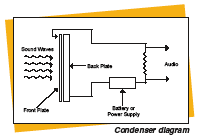3--Condenser Microphones
 Condenser microphones are typically found in the studio. The element is made
up of a thin film coated with a conductive material such as silver or gold which is
suspended over a polarized (powered) backplate. This condenser diaphragm is
part of an electrical circuit that changes voltage with movement and this voltage
becomes the output of the microphone. Sensitivity, wide frequency response and
transient response were always the performance advantages of condenser
microphones over ribbons, dynamics and all other types of microphones.
Condenser microphones are typically found in the studio. The element is made
up of a thin film coated with a conductive material such as silver or gold which is
suspended over a polarized (powered) backplate. This condenser diaphragm is
part of an electrical circuit that changes voltage with movement and this voltage
becomes the output of the microphone. Sensitivity, wide frequency response and
transient response were always the performance advantages of condenser
microphones over ribbons, dynamics and all other types of microphones.
Unlike dynamics or ribbons, condensers require a power source to operate. This power is typically delivered via an external "power supply" or something called "phantom power". Phantom power is a dc voltage fed back through the microphone cable from the console or mic preamplifier to the microphone to run its internal electronics. The term "phantom" was coined because there is no additional wiring or connections to carry the dc power from the console to the microphone. Most all consoles or mic preamps have a built-in 48 volt phantom supply that can be sent to the condenser mic up the mic cable.
The phantom power situation is also something you must be careful of. These microphones are more susceptible to RF and electrical interference since you have dc voltage being fed on the exact same two conductors as the audio from the microphone to the console. Because there is no heavy voice coil attached to the diaphragm.
Because there is no heavy voice coil attached to the diaphragm, the diaphragm is exceedingly low in weight (low mass) and it puts up little resistance to being moved at higher audio frequencies. The trade off of this wider response is that the output of this light diaphragm is so low that it requires another amplifier inside the mic to boost its output up to a level that mic pre-amps can work on. We now need even more power and more electronics! Condensers are fragile beasts and require delicat handling, something you will never want to take on a long concert tour and rely on every night (without lots of expensive back up mics)!
The lighter diaphragm inside condenser microphones means they are extremely sensitive to sounds. It has always been the condenser's strength in a controlled environment but its downfall is in uncontrolled environments, such as live sound stages or commercial broadcast studios. While you may want every nuance of a quiet oboe or violin in the recording studio, on a concert stage you may not want the lady in the 5th row's sneeze to come through as clear as a bell.
While you may want the subtle tone of a person's singing voice in the studio, the loud squeak of camera wheels on a TV news stage is not good! Picking up too much has always been the problem with condensers, especially in the hands of lesser experienced users or in less controlled environments. Even with a proper cardioid pattern, a bad room will make a condenser sound bad. Condensers are wonderful but environmentally critical.